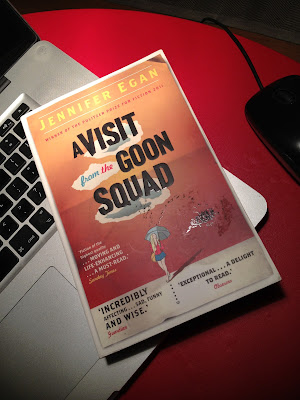However, I have just finished a novel in which one chapter is written using only PP slides. The idea of using PP software in storytelling almost seems to contradict the arguments levelled at its use in business and education.
Having an interest in the role of narrative in the lecture, I was really looking forward to reading Jennifer Egan's A Visit from the Goon Squad, and seeing how she used PP in fictional literature.
 |
| Jennifer Egan's A Visit from the Goon Squad |
I read the paperback version of the book but apparently in the Kindle version the PP actually launches and you read the chapter as an actual presentation of the slides rather than a series of pages, as you do in the book version (see photo below). The chapter is written from the perspective of Alison Blake, a young American pre-teen, who expresses herself in the graphs and SmartArt of PP rather than traditional prose. Part of the narrative involves Alison's take on her brother Lincoln's actions and communication with other members of the family.
 |
| A page from the PowerPoint chapter |
I really enjoyed the book, which has been a tremendous success for Egan, winning the Pulitzer Prize for fiction. It employs quite a loose narrative structure where a series of short stories are linked through a shared character in each sucessive story, with an arc that comes back to first story.
The use of PP works very well for a single chapter but I'm not sure it could have been sustained for the whole, or the majority, of the book. It works so well because PP forces a different pace of narrative compared with the other chapters. It manages this by focusing on a set of significant moments, rather than the links between events. Egan, herself has said that she found PP very good for inserting visual pauses into the story, which is not something that can be done in traditional prose.
Anyway, Egan is a PP novelist having created PP fiction and has written a blog giving advice on how to tell stories using PP.
No comments:
Post a Comment